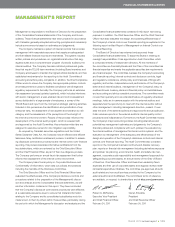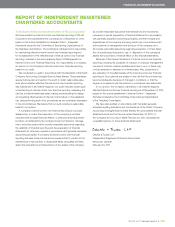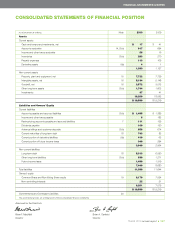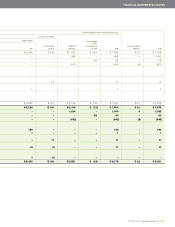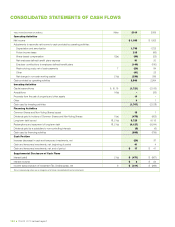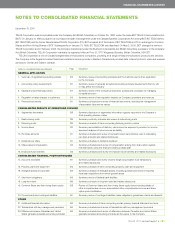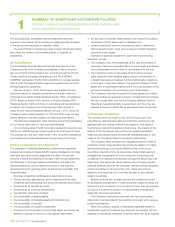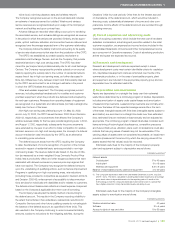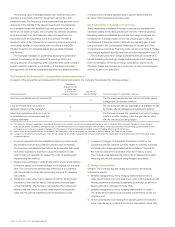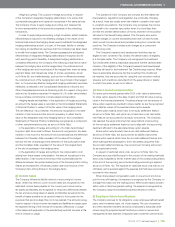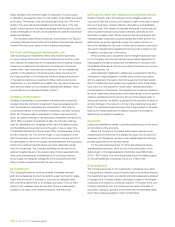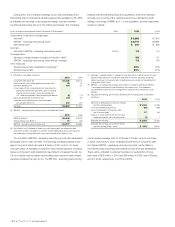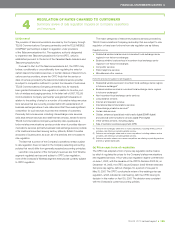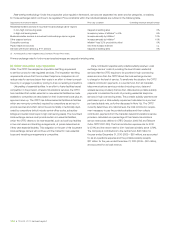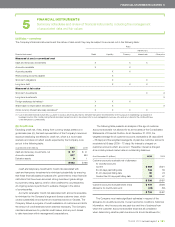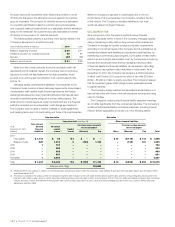Telus 2010 Annual Report Download - page 127
Download and view the complete annual report
Please find page 127 of the 2010 Telus annual report below. You can navigate through the pages in the report by either clicking on the pages listed below, or by using the keyword search tool below to find specific information within the annual report.
TELUS 2010 annual report . 123
Decisions’ initial four-year periods. Other than for the interest accrued
on the balance of the deferral account, which would be included in
financing costs, substantially all statement of income and other com-
prehensive income effects of the deferral account are recorded through
operating revenues.
(d) Cost of acquisition and advertising costs
Costs of acquiring customers, which include the total cost of hardware
subsidies, commissions, advertising and promotion related to the initial
customer acquisition, are expensed as incurred and are included in the
Consolidated Statements of Income and Other Comprehensive Income
as a component of Operations expense. Costs of advertising production,
airtime and space are expensed as incurred.
(e) Research and development
Research and development costs are expensed except in cases
where development costs meet certain identifiable criteria for capitaliza-
tion. Capitalized development costs are amortized over the life of the
commercial production, or in the case of serviceable property, plant
and equipment, are included in the appropriate property group and are
depreciated over its estimated useful life.
(f) Depreciation and amortization
Assets are depreciated on a straight-line basis over their estimated
useful life as determined by a continuing program of studies. Depreciation
includes amortization of assets under capital leases and amortization
of leasehold improvements. Leasehold improvements are normally amor-
tized over the lesser of their expected average service life or the term
of the lease. Intangible assets with finite lives (intangible assets subject to
amortization) are amortized on a straight-line basis over their estimated
lives; estimated lives are reviewed at least annually and are adjusted as
appropriate. The continuing program of asset life studies considers such
items as timing of technological obsolescence, competitive pressures
and future infrastructure utilization plans; such considerations could also
indicate that carrying values of assets may not be recoverable. If the
carrying values of assets were not considered recoverable, an impairment
provision (measured at the amount by which the carrying values of the
assets exceed their fair values) would be recorded.
Estimated useful lives for the majority of the Company’s property,
plant and equipment subject to depreciation are as follows:
Estimated useful lives(1)
Network assets
Outside plant 17 to 40 years
Inside plant 5 to 15 years
Wireless site equipment 6.5 to 8 years
Balance of depreciable property, plant and equipment 4 to 20 years
(1) The composite depreciation rate for the year ended December 31, 2010, was 5.1%
(2009 – 5.4%). The rate is calculated by dividing depreciation expense by an average
gross book value of depreciable assets for the reporting period. A result of this
methodology is that the composite depreciation rate will be lower in a period that
has a higher proportion of fully depreciated assets remaining in use.
Estimated useful lives for the majority of the Company’s intangible
assets subject to amortization are as follows:
Estimated useful lives
Wireline subscriber base 40 years
Software 3 to 5 years
Access to rights-of-way and other 8 to 30 years
Voice local, voice long distance, data and wireless network:
The Company recognizes revenues on the accrual basis and includes
an estimate of revenues earned but unbilled. Wireline and wireless
service revenues are recognized based upon usage of the Company’s
network and facilities and upon contract fees.
Advance billings are recorded when billing occurs prior to rendering
the associated service; such advance billings are recognized as revenue
in the period in which the services are provided. Similarly, and as appro-
priate, upfront customer activation and connection fees are deferred and
recognized over the average expected term of the customer relationship.
The Company follows the liability method of accounting for its quality
of service rate rebate amounts that arise from the jurisdiction of the CRTC.
The CRTC has established a portable subsidy mechanism to
subsidize Local Exchange Carriers, such as the Company, that provide
residential service to high cost serving areas. The CRTC has deter-
mined the per line/per band portable subsidy rate for all Local Exchange
Carriers. The Company recognizes the portable subsidy on an accrual
basis by applying the subsidy rate to the number of residential network
access lines it has in high cost serving areas, as further discussed in
Note 4(c). Differences, if any, between interim and final subsidy rates set
by the CRTC are accounted for as a change in estimate in the period
in which the CRTC finalizes the subsidy rate.
Other and wireless equipment: The Company recognizes product
revenues, including wireless handsets sold to re-sellers and customer
premises equipment, when the products are delivered and accepted by
the end-user customers. Revenues from operating leases of equipment
are recognized on a systematic and rational basis (normally a straight-line
basis) over the term of the lease.
Non-high cost serving area deferral account: On May 30, 2002,
and on July 31, 2002, the CRTC issued Decision 2002-34 and Decision
2002-43, respectively, pronouncements that affected the Company’s
wireline revenues initially for the four-year periods beginning June 1, 2002,
and August 1, 2002, respectively; subsequently the pronouncements
were extended by one year. In an effort to foster competition for residen-
tial basic service in non-high cost serving areas, the concept of a deferral
account mechanism was introduced by the CRTC, as an alternative
to mandating price reductions.
The deferral account arises from the CRTC requiring the Company
to defer the statement of income recognition of a portion of the monies
received in respect of residential basic services provided to non-high
cost serving areas. The revenue deferral was based on the rate of infla-
tion (as measured by a chain-weighted Gross Domestic Product Price
Index), less a productivity offset, and other exogenous factors that were
associated with allowed recoveries in previous price cap regimes that
have now expired. The Company may recognize the deferred amounts
upon the undertaking of qualifying actions, such as Service Improvement
Programs in qualifying non-high cost serving areas, rate reductions
(including those provided to competitors as required in Decision 2002-34
and Decision 2002-43), enhancement of accessibility to telecommunica-
tions services for individuals with disabilities and/or rebates to customers.
The deferral account balance also reflects an interest expense component
based on the Company’s applicable short-term cost of borrowing.
The Company has adopted the liability method of accounting for
the deferral account. This results in the Company recording a liability to
the extent that activities it has undertaken, realized rate reductions for
Competitor Services and other future qualifying events do not extinguish
the balance of the deferral account, as quantified in Note 21(b). This
also resulted in the Company continuing to record incremental liability
amounts, subject to reductions for the mitigating activities, during the
FINANCIAL STATEMENTS & NOTES: 1


